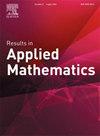Mixing cubic quasi-interpolation spline collocation method and optimal control techniques to solve polyharmonic (p=2 and p=3) problem
IF 1.3
Q2 MATHEMATICS, APPLIED
引用次数: 0
Abstract
This paper solves the polyharmonic equation for the cases and , using an optimal control approach combined with the cubic quasi-interpolation spline collocation method. Specifically, the biharmonic and triharmonic problems are addressed by decomposing the high-order equation into a system of Poisson equations, which are then transformed into a minimization problem, following the principles of optimal control theory. The objective functional is constructed based on Neumann boundary conditions, while the constraints correspond to the Poisson equations resulting from the decomposition of the original problem. As the biharmonic case has been previously studied in Boudjaj et al. (2019), the main novelty of this work lies in the theoretical and numerical treatment of the triharmonic case. This case is reformulated as an optimal control problem, for which we prove the existence and uniqueness of the solution. Numerical experiments are carried out using the cubic quasi-interpolation spline collocation method. The results are compared with those obtained using the Localized Radial Basis Function (LRBFs) collocation method, highlighting the accuracy and efficiency of the proposed approach.
混合三次拟插值样条配点法和最优控制技术求解多谐(p=2和p=3)问题
本文采用最优控制方法结合三次拟插值样条配点法,求解了p = 2和p = 3情况下的多谐方程。具体来说,双调和和三调和问题是通过将高阶方程分解成泊松方程组来解决的,然后根据最优控制理论的原理将泊松方程组转化为最小化问题。目标泛函基于Neumann边界条件构造,约束对应于原问题分解得到的泊松方程。由于Boudjaj等人(2019)之前已经研究了双谐波情况,因此这项工作的主要新颖之处在于对三谐波情况的理论和数值处理。将该问题转化为最优控制问题,证明了其解的存在唯一性。采用三次拟插值样条配点法进行了数值实验。将所得结果与局部径向基函数(LRBFs)配置方法进行了比较,验证了该方法的准确性和效率。
本文章由计算机程序翻译,如有差异,请以英文原文为准。
求助全文
约1分钟内获得全文
求助全文
来源期刊

Results in Applied Mathematics
Mathematics-Applied Mathematics
CiteScore
3.20
自引率
10.00%
发文量
50
审稿时长
23 days
 求助内容:
求助内容: 应助结果提醒方式:
应助结果提醒方式:


